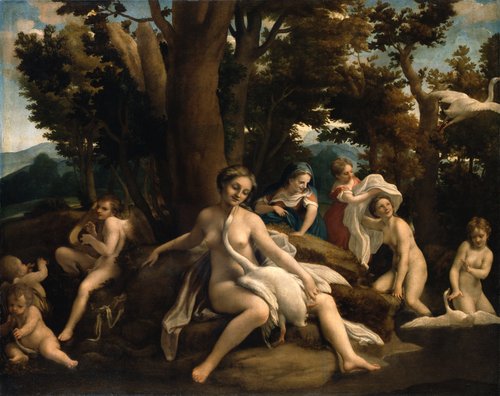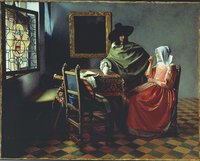Das Bild gehört zu einem Zyklus mit Darstellungen von Liebesabenteuern des Jupiter in verwandelter Gestalt, den Correggio im Auftrag des Herzogs von Mantua, Federico II. Gonzaga, um 1530/32 malte. Leda war die Tochter des Thestios, des Königs von Ätolien, und Gemahlin des Spartanerkönigs Tyndareos. Von den sehr verschiedenen Überlieferungen des Mythos ist in Correggios Bild die verbreitetste Version dargestellt: Am Ufer des Eurotas nähert sich Jupiter in Gestalt eines Schwans Leda und verführt sie. In der Bildmitte, am Ufer vor einer Baumgruppe, sieht man Leda mit dem Schwan, links zwei kleine Amoretten mit Blasinstrumenten und den geflügelten, jünglingshaften Amor mit der Leier, dem apollinischen Instrument göttlicher Musik. Von dem Zyklus sind neben der Leda das fast gleich große Bild der Danae (Rom, Galleria Borghese) sowie zwei Hochformate erhalten, die Entführung des Ganymed und Jupiter und Io (Wien, Kunsthistorisches Museum). Vasari (1550/68), der die Bilder nicht persönlich gesehen, sondern nur durch den in Mantua wirkenden Giulio Romano von ihnen gehört hatte, berichtet, daß Correggio »zwei Bilder in Mantua für Herzog Federico II. gemacht habe, die dem Kaiser geschickt werden sollten«: eine Leda und eine Venus, mit der er die Danae gemeint haben könnte, wobei gewisse Einzelheiten seiner Beschreibung eher auf die Io passen. Federico könnte die vier Bilder für sich selbst bestellt haben, wie Verheyen (1966) glaubte und Gould (1976) als möglich einräumte. Er könnte aber auch, wie Gould vorschlug, die beiden von Vasari nicht eigens erwähnten Hochformate zunächst für sich selbst bestellt haben und, als Kaiser Karl V. diese sah und bewunderte, sie ihm geschenkt haben mit dem Versprechen, noch zwei weitere Bilder (Leda und Danae) zu liefern, die er dann bei Correggio für den Kaiser bestellt hätte. Bis vor kurzem bezog man Vasaris Angaben auf die Krönung Karls V. in Bologna 1530 (und die Thronbesteigung Federicos in Mantua im gleichen Jahr). Gould meinte, daß sich der von Vasari beschriebene Vorgang bei einem der beiden Besuche des Kaisers in Mantua zugetragen habe, wahrscheinlich bei dem zweiten im November 1532. Im September 1534, ein halbes Jahr nach Correggios Tod, begann ein Briefwechsel zwischen dem Herzog und dem Gouverneur von Parma, der Correggios Kartons der Jupiterabenteuer betraf. Gould bezog diese Kartons nicht auf die erhaltenen vier Bilder, wohl aber Verheyen, der aus den Briefen ableitete, daß der Zyklus noch mehr Bilder umfaßt habe. Verheyen stellte die Hypothese auf, daß die Bilder die »Sala di Ovidio« im Palazzo del Tè, der Sommerresidenz des Herzogs, schmücken sollten. Dieser Raum gehörte zu einem »Appartamento«, das vielleicht für die offizielle Mätresse des Herzogs, Isabella Boschetti, bestimmt war. Gould und andere Forscher beurteilten Verheyens Hypothese und Rekonstruktion der Raumdekoration skeptisch. Die späteren Geschicke der Bilder waren äußerst wechselvoll. Danae und Io gelangten in den Besitz des Bildhauers Leone Leoni in Mailand. 1601 kaufte der kaiserliche Gesandte in Madrid sie von dessen Sohn Pompeo für Kaiser Rudolf II. von Habsburg in Prag. 1603 erwarb dieser auch die Leda und den Ganymed von König Philipp III. von Spanien, dem Sohn Philipps II. Die Leda ist das einzige Bild des Zyklus’, das im Nachlaßinventar Philipps II. aufgeführt ist. Vor dem Abtransport nach Prag wurden die Bilder im Auftrag Philipps III. von Eugenio Caxés kopiert. Leda und Danae gehörten zur Beute der schwedischen Truppen, die 1648 Prag eroberten, und wurden nach Stockholm gebracht. Königin Christine von Schweden nahm sie nach ihrer Abdankung 1654 mit nach Rom. Nach ihrem Tod (1689) gelangten sie 1721 in die Sammlung des Regenten von Frankreich, Herzog Philippe von Orléans (1674-1723). Sein Sohn Louis (1703-1752), der die Darstellung der Leda anstößig fand, zerstückelte das Bild in einem Anfall religiösen Wahns. Er gab die einzelnen Teile dem Hofmaler und Kurator seiner Sammlung, Charles Coypel, der das Bild wieder zusammensetzen und restaurieren durfte. Bei der Versteigerung der Sammlung 1753 waren die Stücke offenbar noch nicht wieder zusammengefügt. Für den Käufer Pasquier setzte die Witwe Godefroi sie wieder zusammen, und der Maler Delyen restaurierte den Kopf. Pasquier starb schon zwei Jahre später. Auf der Auktion seiner Sammlung erwarb der Graf d’Epinaille das Bild für Friedrich den Großen, in dessen Gemäldegalerie in Potsdam es 1770 von Matthias Oesterreich beschrieben ist. Als 1806 Napoleon das Bild nach Paris bringen ließ, restaurierte Prudhon den Kopf der Leda erneut. Die letzte Restaurierung bzw. Neumalung des Kopfes erfolgte durch Jakob Schlesinger in Berlin 1834/35. Der Kopf war ursprünglich mehr nach rechts geneigt.| 200 Meisterwerke der europäischen Malerei - Gemäldegalerie Berlin, 2019 :::::::::::_ This picture is part of a cycle that depicts the amorous adventures of Jupiter in various states of transformation, which was painted in circa 1532 by Correggio on a commission from Federico II Gonzaga, the Duke of Mantua. Leda was the daughter of Thestios, the King of Aetolia, and the wife of the Spartan King Tyndareos. From among the highly various available versions of the myth, Correggio’s picture represents the most widely disseminated one: on the banks of the Eurotas River, Jupiter approaches Leda in the guise of a Swan and seduces her. Shown at the centre of the picture, at the water’s edge and in front of a grove of trees, are Leda and the Swan, and on the left, two small amorettes with wind instruments and a winged, youthful Amor with a lyre, the Apollonian instrument of divine music. Surviving from this cycle in addition to the Leda are the Danae (Rome, Galleria Borghese), which is nearly the same size, as well as a pair of works having vertical format, the Abduction of Ganymede and Jupiter and Io (Vienna, Kunsthistorisches Museum). Vasari (1550/68) – who never saw these pictures personally, and instead heard about them from Giulio Romano, who was active in Mantua – reports that Correggio “created two pictures in Mantua for Duke Federico II, which are to be sent to the Emperor”: a Leda and a Venus, whereby he may well have been referring to the Danae, although certain details of his description seem closer to the Io. Federico may have commissioned the pictures for his own use, as Verheyen (1966) believed, and Gould (1976) regarded as possible. As Gould has proposed, it may also be that he at least initially commissioned the two vertical format works not specifically mentioned by Vasari for his own use, and had them delivered to the Emperor Charles V only after the latter had seen and admired them, accompanied by the promise to supply two further paintings (the Leda and the Danae), which he then commissioned for the Emperor from Correggio. Until recently, Vasari’s information was associated with the coronation of Charles V in Bologna in 1530 (and with Federico’s accession to the throne in Mantua that same year). Gould believed that the events described by Vasari must have taken place during one of the Emperor’s two visits to Mantua, more probably during the second visit in November of 1532. Commencing in September of 1534, six months after Correggio’s death, was an exchange of letters between the Duke and the Governor of Parma, which concerned Correggio’s cartoons for the adventures of Jupiter. Gould does not relate these cartoons to the surviving four pictures, unlike Verheyen, who concluded on the basis of the letters that the cycle must originally have included additional pictures. Verheyen proposed the hypothesis that the pictures had been intended to decorate the “Sala di Ovidio” in the Palazzo del Tè, the Duke’s summer residence. This room was part of an “appartamento” that may have been intended for Isabella Boschetti, the Duke’s official mistress. Gould and other scholars have regarded Verheyen’s hypothesis and reconstruction of the room decor with some scepticism. The later history of these pictures is full of vicissitudes. Danae and Io entered the collection of the sculptor Leone Leoni in Milan. In 1601, the imperial envoy in Madrid purchased them from Leoni’s son Pompeo for the Habsburg Emperor Rudolf II in Prague. In 1603, Rudolf also managed to acquire the Leda and the Ganymede from King Philip III of Spain, the son of Philip II. The Leda is the only member of the cycle to be entered into the inventory of the estate of Philip II. Prior to their transport to Prague, the pictures were copied by Eugenio Caxés through a commission by Philip III. The Leda and the Danae were among the booty taken by the Swedish troops who conquered Prague in 1648, and were brought to Stockholm. Following her abdication in 1654, Queen Christine of Sweden took them with her to Rome. In 1721, subsequent to the Queen’s death in 1689, they entered the collection of the Duke Philippe of Orléans, Regent of France (1674–1723). His son Louis (1703–52), who found the depiction of Leda offensive, dismembered the picture in a seizure of religious frenzy. He gave the individual parts to Charles Coypel, his court painter and curator of his collection, who received permission to reassemble and restore the picture. When the collection was auctioned in 1753, apparently, the pieces had however not yet been rejoined. Godefroi’s widow performed this task for the next purchaser, Pasquier, and the painter Delyen restored the head. Pasquier died just two years later. At the auction in his collection, the Count d’Epinaille acquired the picture for Frederick the Great; its presence in Frederick’s Bildergalerie in Potsdam in 1770 is described by Matthias Oesterreich. In 1806, when Napoleon had the picture brought to Paris, Prudhon produced a new restoration of Leda’s head. The most recent restoration, which involved repainting the head, was the work of Jakob Schlesinger, and took place in Berlin in 1834/35. Originally, her head was turned more toward the right.| 200 Masterpieces of European Painting - Gemäldegalerie Berlin, 2019
de

